Latin America
About Andrew Cusack
 Writer, web designer, etc.; born in New York; educated in Argentina, Scotland, and South Africa; now based in London.
Writer, web designer, etc.; born in New York; educated in Argentina, Scotland, and South Africa; now based in London. read more
News
Blogs
Reviews & Periodicals
Arts & Design
World
France
Mitteleuropa
Knickerbockers
Argentina
The Levant
Africa
Cape of Good Hope
Netherlands
Scandinavia
Québec
India
Muscovy
Germany
Academica
A Realm That Never Was
The United Kingdom of the Rio de la Plata, Chile, and Peru
If we give in to temptation and attempt to see things without the benefit of hindsight, Brazil’s path to independence as a monarchy is less surprising than the fact that Argentina didn’t pursue a similar trajectory. After all: Argentina’s ‘Liberator’, José de San Martín, was himself a monarchist, as was Manuel Belgrano.
Belgrano’s project was to unite the Provinces of the River Plate with Chile and the old viceroyalty of Peru in one united kingdom under a Borbón king. This was to be the Infante Don Francisco de Paula, the youngest son of Charles IV of Spain, but the Spanish king ardently refused to yield his throne’s sovereignty over the new world, nor to allow any of his offspring to take part in the various projects for local monarchies.
When that failed, Belgrano proposed to the Congress of Tucumán that they crown an Incan as king. San Martín, Güemes, and others supported this, but Buenos Aires resisted the plan. They proposed instead to crown Don Sebastián, a Spanish prince living in Rio de Janeiro with his maternal grandfather, King João VI of Portugal.
João thought the scheme would end up injurious to Portugal’s interests and so put the kibosh on it.
And don’t get us started on Carlotism, which was a whole ’nother pile of tricks.
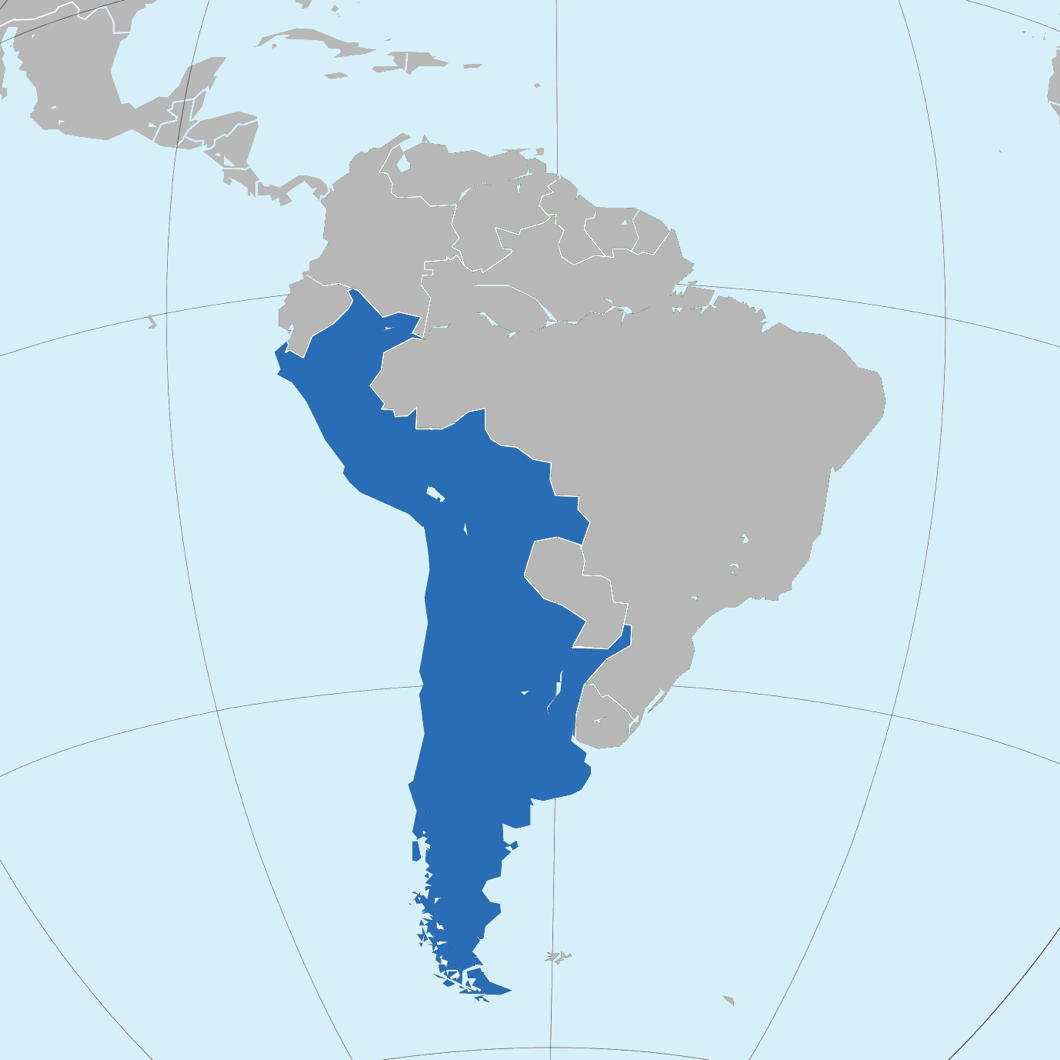
Belgrano’s monarchic project in its 1815 iteration was to unite the provinces of the River Plate with Chile and the old viceroyalty of Peru to create a single realm out of these Spanish-speaking territories.
He even drafted a constitution for the United Kingdom of the Rio de la Plata, Chile, and Peru, which is rudimentarily translated into English below. This even went so far as to specify the coat of arms and flag of the kingdom.
The best history covering these unconsummated plans remains Bernado Lozier Almazán’s 2011 book Proyectos monárquicos en el Río de la Plata 1808-1825: Los reyes que no fueron which sadly has not yet been translated into English.
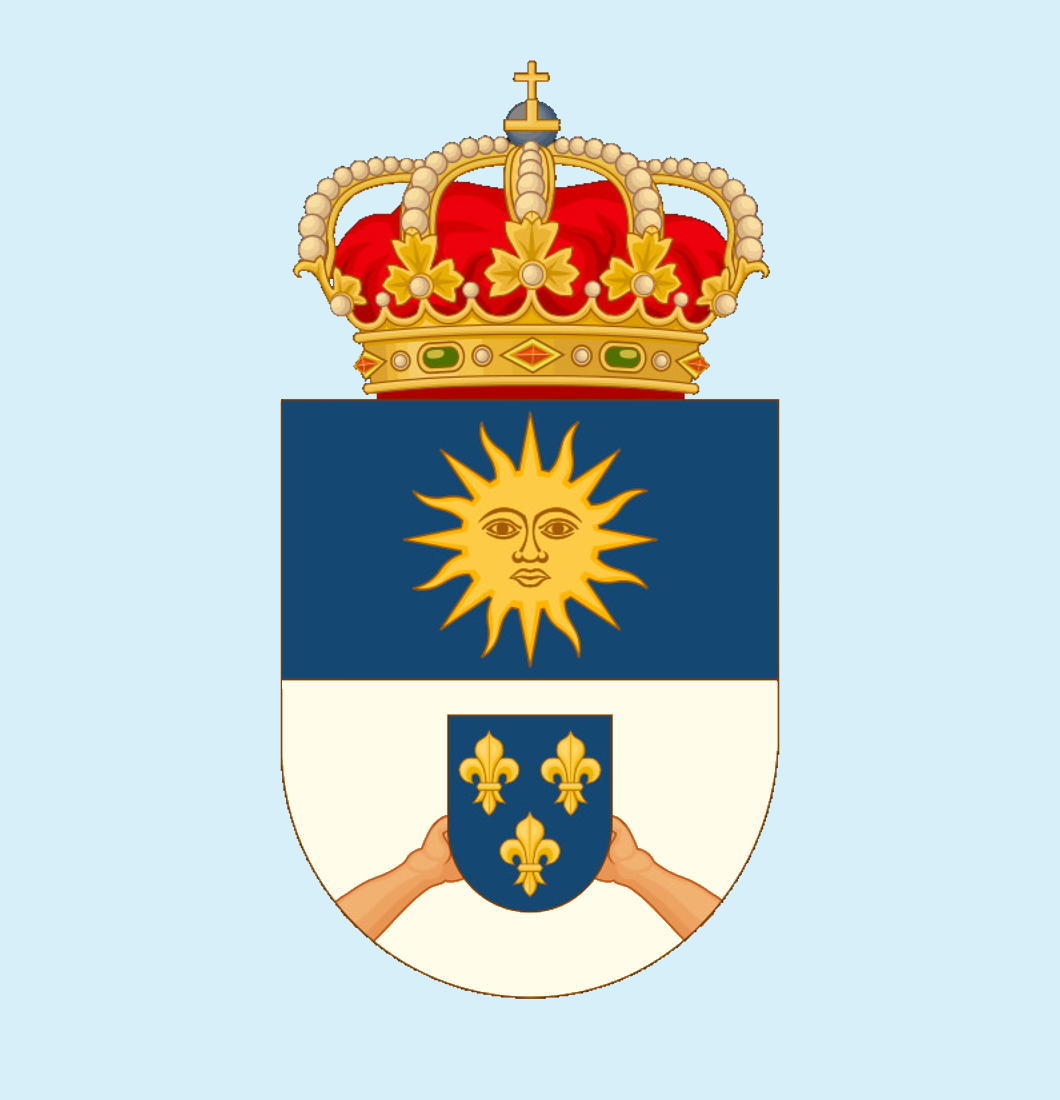
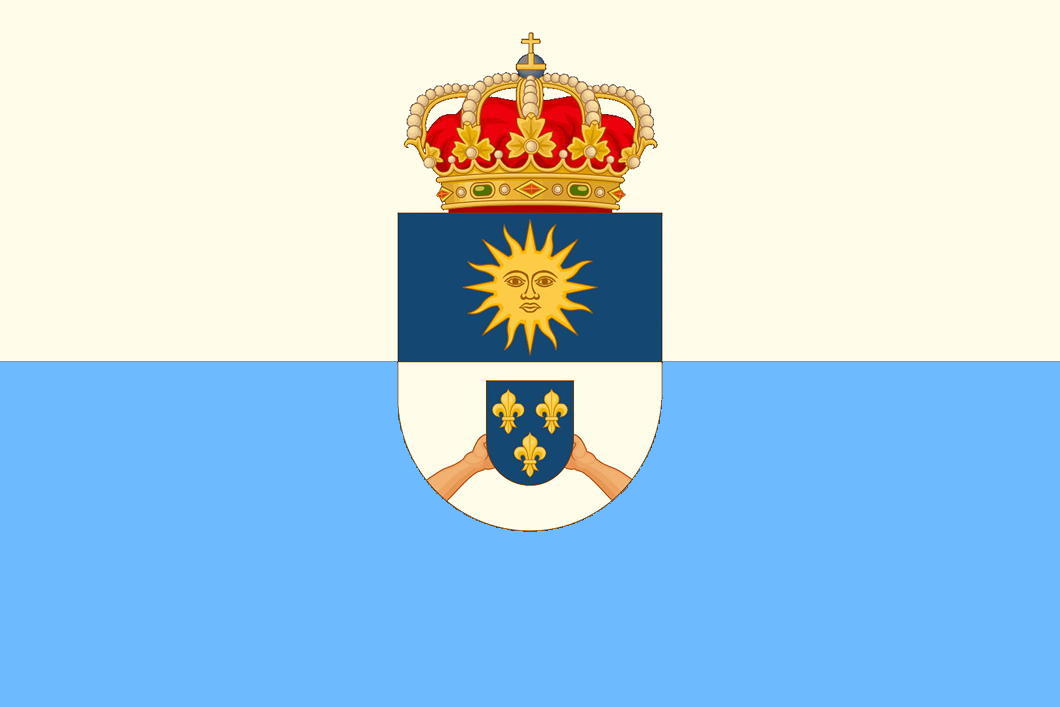
Article 1 — The new Monarchy of South America will have the name of the United Kingdom of the Río de la Plata, Peru, and Chile; its coat of arms will be a shield that will be divided into blue and silver fields; In the blue that will occupy the upper part, the image of the Sun will be placed, and in Silver two arms with their hands that will hold the three flowers of the emblems of My Royal Family; surmounted by the Royal Crown, and will have as supporters a tiger and a llama. Its flag will be white and light blue.
Article 2 — The Crown will be hereditary in order of proximity in the lines of agnation and cognation.
Article 3 — If, God forbid, the current King dies without succession, his rights will revert to me so that with the agreement and consent of the Legislative Body I choose another Sovereign from my Royal Family; but, if I no longer exist, said Chambers will have the power to elect one of the princes of my Blood Royal as their King.
Article 4 — The person of the King is inviolable and sacred. The Ministers are responsible to him. The King will command the forces of sea and land; he will declare war, he will make peace; he will make treaties of alliance and trade; he will distribute all the offices, he will be in charge of the public administration, the execution of the laws, and the security of the State to whose objects he will give the necessary orders and regulations.
Article 5 — The King will name all the nobility; he will grant all the dignities, he will be able to vary them and grant them for life, or make them hereditary. The King may forgive offences, commute sentences, or dispense them in the cases that the law grants him.
Article 6 — The nobility will be hereditary in the same terms as the Crown; it will be distinguished precisely in three grades, and cannot be extended to more: the first grade will be that of Duke, the second of Count and the third of Marquis; the nobles will be judged by only those of their class, they will have part in the formation of the laws, they will be able to be Deputies of the Towns and they will enjoy the honours and privileges that the law or the King grants them; but they may not be exempted from the charges and services of the State. Any individual of the State of any class and condition may opt for the nobility for their services, for their talents, or for their virtues. The first number of the nobility will be agreed by the King and Representative and at any other time by the Legislative Body.
The Legislative Body
Article 7 — The Legislative Body will be composed of the King, the Nobility, and Representation of the Commons.
The Upper Chamber will be formed: the first part by all the Dukes, whose right is declared inseparable from their dignity; the third part of the Counts, by election among themselves, presided over by a King’s Commissioner; the fourth part of the Marquises, elected on their own terms; and the fifth part of the Bishops of the Kingdom, elected the first time by the King, being in charge of it and the other Chamber, to establish the bases for the election of this body for the future.
Article 8 — The Second Chamber will be made up of the Deputies of the Peoples, who will be elected for the first time in the customary terms that allow less play to the parties, and will consult the greatest opinion, it being an essential charge to the Legislative Body to establish for the latter the most adequate and precise laws.
Article 9 — The power to propose the law will be common to the King and both Chambers; the order of the proposition will be from the King to the First Chamber, and from this to the King, and from the Second to the First, in the event that a proposal is not admitted by its immediate chamber, it cannot go to the third, nor be repeated until another session. Every law will be the result of the plurality of both Chambers, and secondly of the King; the sanction and promulgation of the law will be exclusively his.
The chambers may not join or dissolve without the express order of the King. He will be able to extend them for as long as he deems it necessary, and dissolve that of the Deputies when he deems it appropriate.
Article 10 — The designation of the King’s income, his Royal House and Family, the expenses of his Minister and Cabinet, the civil list, the military, and extraordinary expenses will be exclusively agreed by both Chambers, to which in the same way belongs to the arrangement and imposition of rights and contributions.
The Ministry
Article 11 — No order of the King without the authorisation of his corresponding Minister will be fulfilled; the Ministers will have the power to propose to both Chambers what they deem appropriate, and enter any of them to report what they deem appropriate; the Ministers will indispensably be Members of the High Court, and only by it may they be judged. The Ministers may not be accused except for treason or extortion, the accusation will not be admissible unless it is made by the plurality of one or another Chamber; the Minister of Finance will present to both Chambers for their knowledge and approval the accounts of the previous year.
The Judiciary
Article 12 — The judges will be appointed by the King; they will be perpetual and independent in their administration, only in the case of notorious injustice or ruling can they be accused before the Upper Chamber who will judge them independently of the King, who will protect and execute their decisions in this part; The judges of the fact will be established, called the jury in the most adaptable way to the situation of the Towns.
The Commonalty of the Nation
Article 13 — In addition to the proportionate and uniform distribution of all charges and services of the State, the option to nobility, jobs and dignities, and the common competition and subjection to the law; The Nation will enjoy, with the inalienable right to property, freedom of worship and conscience, freedom of the press, the inviolability of property, and individual security in the terms clearly and precisely agreed upon by the Legislative Power.
Those elected by the nobility, clergy, and commonalty will last six years, starting to renew the first elected by half every three years: The Common Deputies may not be executed, persecuted, or tried during their commission, except in cases that the law designated and by the Chamber itself to which they belong.
Past and Future Meet in Peru’s Navy
Lima’s Latest Warship Boasts Four Masts and Full Rigging
Today the Peruvian Navy’s newest ship, the BAP Unión, returns to its home port of Callao after an 8,900-mile tour at sea that took in eight countries over 98 days. But though commissioned earlier this year by then-President Ollanta Humala, the Unión isn’t some grey-painted stealth frigate but a four-masted, steel-hulled, full-rigged barque. Named after a corvette that saw action in the War of the Pacific, the Unión was laid down at Callao’s SIMA shipworks in 2010, launched in 2014, and was commissioned this past January as the primary training vessel of the Peruvian fleet.
The unimaginative might be surprised that such old-school ships are being used to train modern sailors, but the Unión’s Commander Roberto Vargas is unambiguous.
“On modern warships, working with computers and satellites all the time, we forget that we have to learn the essentials of sailing,” Commander Vargas told the Miami Herald.
“On a ship like the Unión, these cadets learn leadership, they learn cooperation, they learn group spirit. It’s impossible to work alone with these big sails — you have to work with other people. And most of the basics, like navigation and oceanography, are the same.”
Many other Latin American countries use tall ships as naval training vessels. Argentina’s ARA Libertad was the subject of an attempted seizure by foreign vulture funds seeking payments on debts defaulted upon in 2002.
While most date from the 1960s (Colombia’s Gloria), ’70s (Ecuador’s Guayas; Venezuela’s Simón Bolívar), or ’80s (Mexico’s Cuauhtémoc), Chile’s Esemeralda was launched in 1946. The grande dame of them all is Uruguay’s schooner the Capitán Miranda, launched in 1930 but docked since 2013 awaiting decisions on upgrades.
One analyst notes that even two-hundred years later the old imperial connections are still thriving in the strong Spanish influence on many of these ships:
The Peruvian state-controlled shipyard SIMA (Servicios Industriales de la Marina) constructed the Union in its shipyard in the port of Callao, but the Spanish company CYPSA Ingenieros Navales cooperated in the vessel’s structural design.
As for other ships, many were constructed by Spanish companies. For example Colombia’s Gloria, Ecuador’s Guayas, Mexico’s Cuauhtemoc, and Venezuelan’s Simon Bolivar were all manufactured by Astilleros Celaya S.A., while Chile’s Esmeralda was obtained from the Spanish government which constructed it at the Echevarrieta y Larrinaga shipyard in Cadiz.
One exception to the rule is Brazil’s Cisne Branco, which was constructed by the Dutch company Damen Shipyard.
Given the return to tradition in Peru’s army that we had previously reported on, it’s a pleasure to see this continuing in the country’s navy. Peru continues to show the world that another future is possible.
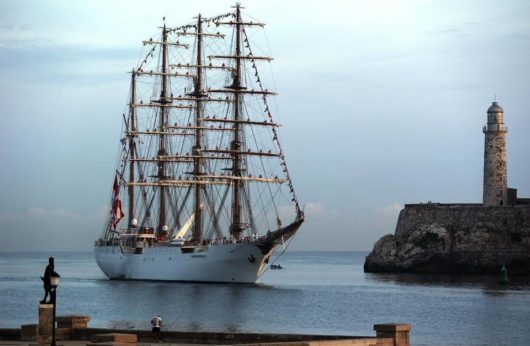
Entering the old harbour of Havana, Cuba.
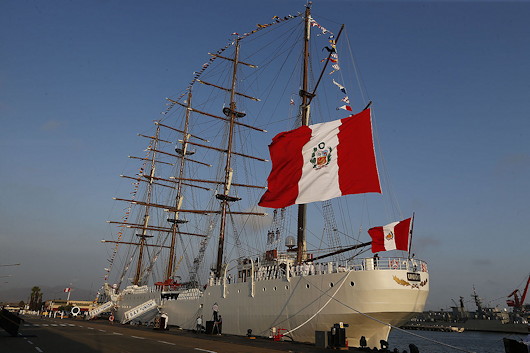
Above and below, decked out for commissioning in Callao.
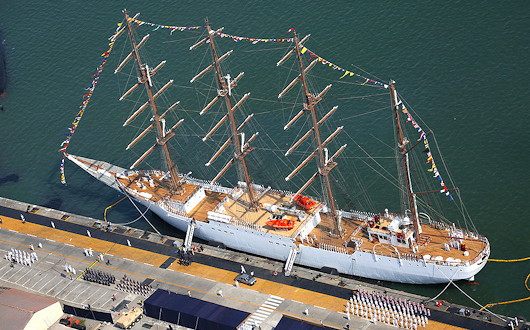
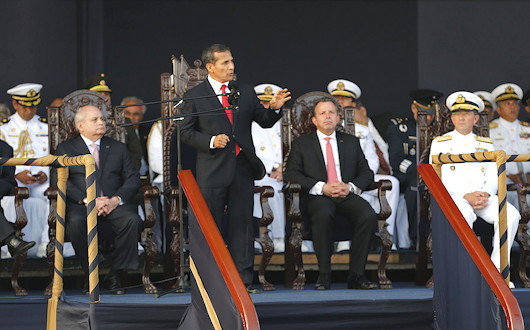
President Humala at the commissioning ceremony.
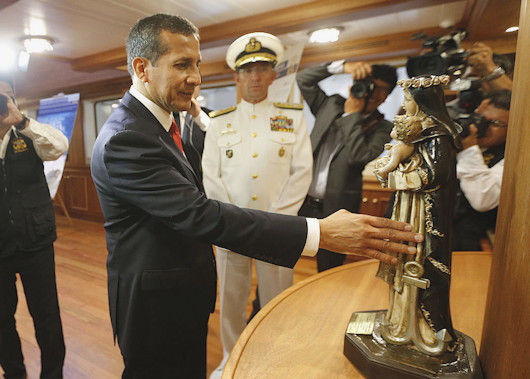
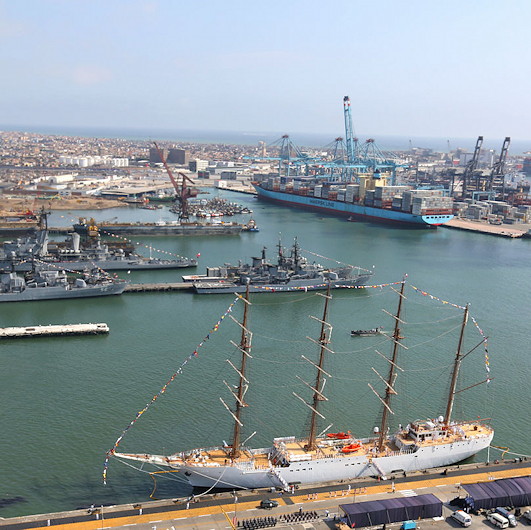
The Start of Something Big in Argentina
The first-ever Nuestra Señora de Cristiandad Pilgrimage to Luján
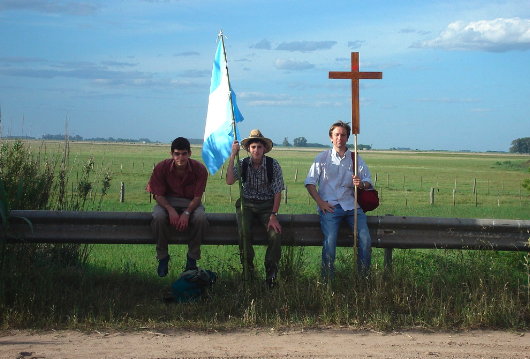
SMALL SEEDS, IF well-planted and tended to, flower into much larger growths. On a Friday morning last month, just four pilgrims set out from the town of Rawson in the Buenos Aires province of Argentina, but by the time they reached their destination — a Latin Mass in the Marian basilica of Luján — their numbers swelled to nearly a hundred. The pilgrimage of November 5th, 6th, and 7th, under the patronage of ‘Our Lady of Christendom’ (Nuestra Señora de Cristiandad) was inspired by the traditional Paris-Chartres pilgrimage every Pentecost weekend. The organisers hope that, like the Chartres pilgrimage, this trek to Luján will become an annual recurring event.
“Renewing Christendom in Argentina” was the theme of this year’s pilgrimage, which “seeks to promote the rich tradition of the Roman Catholic Church for our times” the organisers announced in a press release after its completion.
“This new 100-kilometre pilgrimage was an act of reparation and praise to God, imploring the salvation of souls through the renewal of Christian culture and the rediscovering of the bi-millennial tradition of the Church.” (more…)
Ingrid Betancourt at Castel Gandolfo
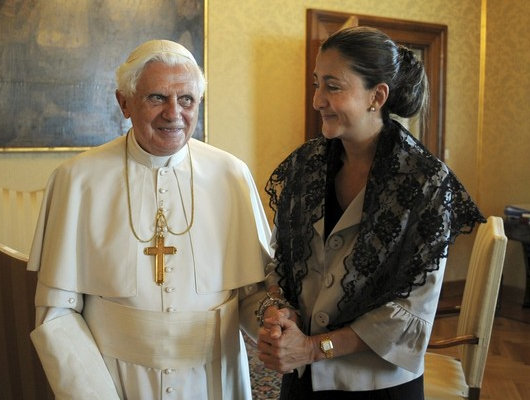
Ingrid Betancourt was welcomed by Pope Benedict XVI at the papal retreat of Castel Gandolfo this week. The Franco-Colombian politician was freed from the communist FARC guerrillas in July by a stealth operation of the Colombian Army in which not a single shot was fired. Betancourt had been held hostage for over six years in the South American jungle. After being reunited with her family, she made a pilgrimage to Lourdes to give thanks for the intercession of the Blessed Virgin in sustaining her during her capitivity.
La Rural
The 122nd Exhibition of the Sociedad Rural Argentina
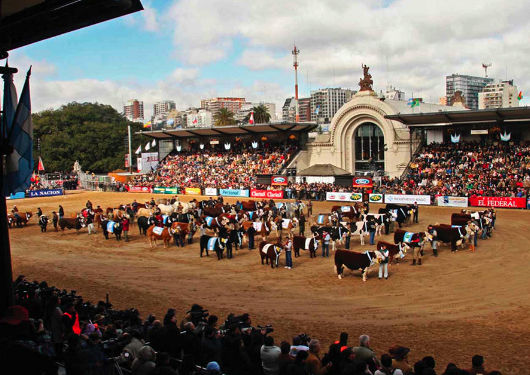
One of the highlights of the Argentina calendar is the Rural Exposition or “La Rural” which takes place every year at the Buenos Aires showgrounds of the Sociedad Rural Argentina. La Rural is one of the few events which takes up the entirety of the Society’s thirty-acre home nudged between Palermo Viejo and Palermo Nuevo and facing onto the Plaza Italia. Lasting from July 24 to August 4, with admission just 13 pesos (about $4.25 or £2.30), the show usually attracts a million visitors over its thirteen days.
High Drama in Argentina’s Halls of Power

IT IS AN age-old question: what happens when an irresistible force meets an immovable object? The force in question is the farming community of Argentina, once among the agricultural powerhouses of the world, and the object is the country’s slippery presidential couple, President Cristina Fernández de Kirchner and her husband (and predecessor in the top job) Néstor Kirchner. From all the way back in March, the Kirchners have been locked in a bitter dispute with the farming sector of the country since the presidential couple unilaterally imposed a massive tax on soy exports.
The Kirchners deride the farmers as “oligarchs” and claim that the exorbitant tax on one of Argentina’s most successful commercial sectors will be redistributed to the poor. Of course it would be irresponsible to simply take from the haves and give to the have-nots; the money raised would only go to the deserving poor, namely those who happen to support the Kirchner regime. Along the way, every cog in the machine will take his fair share, with a respectable amount left over to fatten the calves (metaphorically speaking) of the Kirchnerite street operators who quite openly buy votes during election time and pay union members to show up at pro-government rallies in between.

Argentine farmers protesting the Kirchner soy tax.
Amidst pickelhaubes resplendent
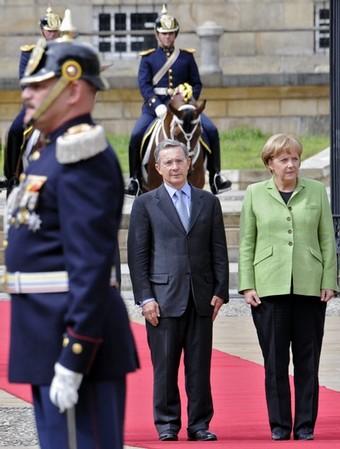
The Chancellor of Germany is seen here worriedly admiring the pickelhaubed cavalry on her state visit to Colombia. Such elements of tradition, widespread in South America, are unofficially but totally banned in Germany.
Uribe for the White House?

Daniel Hannan, the best MEP blogger there is, thinks that Álvaro Uribe should take over the reins of the United States when he finishes his second term as President of Colombia. As Mr. Hannan points out, Uribe “has a better record on defeating terrorism than anyone else in the world, he’s a successful free marketer, and he’s the most pro-US leader in the Western Hemisphere.” Sadly, being pro-US is usually a bad sign in world leaders these days, but President Uribe is the exception that tests the rule.
President Uribe currently enjoys a 90% approval rating; President Bush hovers around 30%, while the United States Congress has reached a whopping 9% approval rating.
Reunited

Ingrid Betancourt sees her children in person for the first time in over six years.
Ingrid Betancourt has described her liberation as a “miracle from the Virgin Mary” and has revealed how prayer kept her going during her six years and five months in captivity, admitting that the temptation of suicide was ever-present.
President Uribe gives credit where credit is due:
Do continue to keep up your prayers for Colombia, a land which is still plagued with many evils, though simultaneously bestowed with many graces.
Gaudium magnum
The fruit of many prayers: Ingrid Betancourt is free

What a splendid thing is the liberation of Ingrid Betancourt after being held in captivity by the FARC for six years and five months. The Franco-Colombian politician was freed by the Armed Forces of Colombia in a raid planned so well that not even a single shot was fired. Ms. Betancourt has hailed the rescue operation as “perfect” and expressed her profound thanks to the Colombian military. It is understood that the commandos had an opportunity to take out as many as fifty FARC guerrillas but declined to both as a token of goodwill and in order to further encourage the massive desertions the FARC has suffered recently.
This is wonderful news for Betancourt’s family, but it is also great for Colombia and for the President of Colombia, Álvaro Uribe. President Uribe has been working feverishly during his time in office to restore the rule of law and the legitimate government throughout the troubled South American country. In contrast to his predecessors, he has been outstandingly successful in fighting the FARC (Revolutionary Armed Forces of Colombia), a Marxist guerrilla group and drug cartel that has terrorized the nation.
You will no doubt recall that President Uribe recently implored the intercession of the Blessed Virgin to prevent a possible war with Venezuela and Ecuador. We should all pray, as President Uribe does, for a Columbia that is united, free, peaceful, and just.
The Primera Revista Latinoamericana

We are of the opinion that the more publications, the merrier, and so we certainly welcome the foundation of the Primera Revista Latinoamerican de Libros. The PRL, which is a sort of Hispanic version of the TLS, started printing last September and is based right here in New York. The bimonthly is published in Spanish but reviews both books that are printed in Spanish and books printed in English. Again, like the TLS, it is not limited to book reviews but features other literary essays as well.

The head honcho at the PRL is Fernando Gubbins, who has earned a master’s degree in Public Affairs from Columbia here in New York and a philosophy degree from the Pontifical Catholic University of Peru. Mr. Gubbins previously edited the opinion & editorial section of the Peruvian newspaper Expreso, and has worked with the Economist Intelligence Unit.
Not being a hispanophone, I am not qualified to render judgement on the quality of the publication’s content, the PRL in print is well designed and has a very traditional but modern feel to it, and it was a pleasure flicking through its pages. The Primera Revista is a welcome addition to the literary world of New York, and of Latin America.

Goosesteps and Pickelhaubes
The Republic of Chile’s Annual ‘Parada Militar’
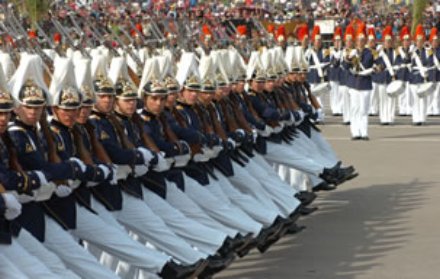
WHILE MANY NATIONS have thrown time-honored traditions and ceremonies to the wind, they remain central to the South American nation of Chile. Through the wisdom of its leaders, be they civil, military, Liberal, Conservative, Radical, Socialist, or Christian Democrat, this republic on the Pacific has not sampled the bitter taste of war since 1883 when they snatched the last remnants of Bolivia’s coastline. (Bolivia, now landlocked and ever holding a grudge, still maintains a small navy in defiance of geography). Having steered clear of the suicidal bloodlust which consumed much of the Western world during the Twentieth Century (say what you will about the deaths of the Allende/Pinochet years, they are far fewer than our dead of the World Wars, Korea, and Vietnam), Chile feels free to continue in the best of its European traditions free from emotional hangups.
For we in the Anglo-American world, goosesteps and pickelhaubes evoke nasty images of Prussian militarism and Nazi hegemony. While the pickelhaube is actually of Prussian origin, having been designed in 1842 by Frederick William IV, the revolutionary Hitler eventually banished them as fusty remnants of the ancien regime. And, while Hitler did popularize the goosestep, this particular form of march has its origins in old Imperial Russia.
Chile is a nation composed of settlers from almost every European country, and has adapted and melded its traditions and culture thencefrom. The ‘Father of the Country’ was an Irishman by the name of Bernardo O’Higgins, while the founder of the Chilean Navy was the 10th Earl of Dundonald. Later immigrants brought influence from Germany, Italy, and other countries, while the founding influence of Spain remained.
Every year, Chile celebrates the ‘Day of the Glories of the Armed Forces’ on September 19, the day following Chile’s Independence Day of September 18 commemorating the 1810 junta. The civil leaders of the land and high-ranking military officers assemble at a stand on the Campos de Marte in the Parque O’Higgins in Santiago and review a long parade of the Army, the Navy, the Air Force, and the Carabineros, Chile’s gendarmerie-style national police.
I’ve always loved a parade, and there is no parade like a military parade, so I decided to share with you a few views of Chile’s annual parada militar. One gets the impression that just before we put the Third Reich out of business, they contracted a huge surplus uniform sale to the Chileans which has left them a bountiful supply of uniforms to this day. Indeed, judging by some of the uniforms, one might even get the impression that the same happened earlier in the century when we (lamentably) forced the Kaiser to close shop. But the Chileans will continue to wear their uniforms with pride, and who can blame them? They look good. (more…)
The Other September 11th
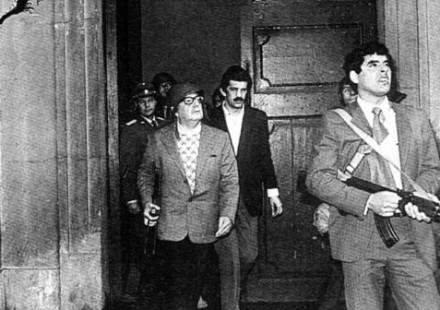
¡No Pasaran! has a post on Chile’s would-be dictator, Salvador Allende (seen above, helmeted, in the last photo taken of him alive). Many left-wing urban intellectuals both in the Americas and Europe fawn over Allende as the heroic democratically-elected savior of the proletariat who was cruelly overthrown by the reactionary military just moments before a Socialist paradise would have been achieved. Nothing could be further from the truth.
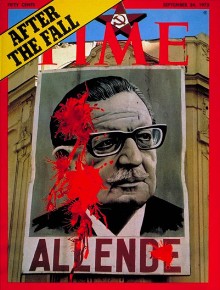
Search
Instagram: @andcusack
Click here for my Instagram photos.Most Recent Posts
- Faithful Shepherd of the Falklands April 8, 2025
- Articles of Note: 8 April 2025 April 8, 2025
- Proportionality Destroys Representation April 8, 2025
- Sag Harbor Cinema March 26, 2025
- Teutonic Takeover March 10, 2025
Most Recent Comments
Book Wishlist
Monthly Archives
Categories


